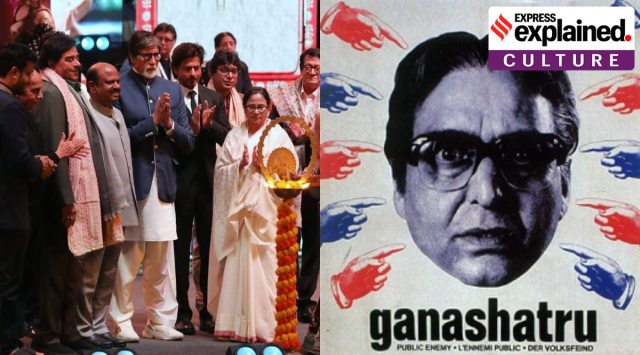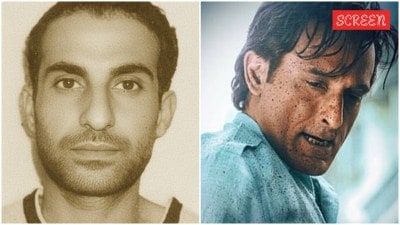In his address, Bachchan spoke about Satyajit Ray, one of India’s most iconic filmmakers. He also mentioned his National Award winning Bangla film Ganashatru (‘Enemy of the People’), wondering if Ray’s reaction to the current scenario would be much like that of the protagonist.

“One of his later films, Ganashatru, can be taken as an indication of how Ray may have reacted to current times. In this chamber drama, about a jaundice epidemic caused by water contamination that is suppressed by both the state and the local temple, Dr Ashoke Gupta (the protagonist) becomes the enemy of the people, fighting for justice,” he said.
What are the issues raised in Ganashatru, and why is the film still relevant? We explain.
The plot of Ganashatru
Ganashatru, an adaptation of Norwegian playwright Henrik Ibsen’s 1882 play An Enemy of the People, revolves around an honest doctor Ashoke Gupta, played by legendary thespian Soumitra Chatterjee. Dr Gupta, alarmed by the rising cases of jaundice among his patients, decides to have water samples from a populated part of his town, Chandipur, analysed.
This report sets in motion the events that change Dr Gupta’s life: it points out that the holy water (‘charanamrita’) of the Tripureshwar temple, a famous temple and tourist attraction of the town, is contaminated. This pollution has occurred due to damage to the underground piping system.
Dr Gupta, in all his sincerity, tries to spread awareness about the contamination among all segments of society, and even proposes temporary closure of the temple for repair work and water purification. However, this is met with vehement opposition from the rich and powerful sections of the town, especially the politicians, for whom the temple had become a thriving source of income.
Story continues below this ad
This opposition includes Dr Gupta’s younger brother Nishith (played by Dhritiman Chatterjee), who is the Chairman of the town’s municipality. He, along with other corrupt elements, distort the doctor’s narrative and try to prevent him from alerting the public.
The political pressure against Dr Gupta leads to the local daily Janabarta not publishing his essay on the issue, despite having shown keen interest earlier.
Later, in one of the most rousing sequences in the film, Dr Gupta attempts to address a public meeting to broadcast his concerns about the water supply directly to the townspeople. However, before the doctor has a chance to speak, the meeting is hijacked by Nishith and his associates. Nishith is successfully able to manipulate the town against his elder brother, making him the “enemy of the people”.
This public anger has destructive consequences for Dr Gupta and everyone in his immediate family— he is terminated from his position at the local hospital, his daughter (played by Mamata Shankar) loses her job as a teacher, and the landlord asks the family to vacate the house.
Story continues below this ad
However, the film ends on a hopeful note: the educated (and mostly young) population of the town chooses to side with Dr Gupta and his son-in-law’s theatre troupe campaigns for his message. The assistant editor of Janabarta resigns, and sends Dr Gupta’s essay to the leading newspapers of Kolkata. The family decides to stay on in Chandipur, with shouts of “Long live Dr Gupta!” all around.
How did Amitabh Bachchan connect Ganashatru to contemporary India?
In his speech at the film festival, Bachchan raised issues of free speech, censorship and civil liberties. The plot of Ganashatru is based largely on how certain truths are censored to protect and favour the powerful elite, to the detriment of the greater good of the society. The film is also concerned with what happens when narratives are manipulated in the name of religion, and how that influences popular discourse.
Bachchan, in his speech, pointed out that the Indian film industry has always propagated courage and managed to keep an egalitarian spirit alive.
“Since early times there have been many changes in cinema content. From mythological films and socialist cinema to the advent of the angry young man and the current brand of historicals, couched in fictionalised jingoism, along with moral policing, the range has kept audiences reflecting on the politics and social concerns of the times,” he said.
Story continues below this ad
Ganashatru’s reception
At the 37th National Film Awards, Ganashatru won the Best Feature Film in Bengali award, “for its brilliant adaptation of Ibsen’s ‘An Enemy of the People’ to highlight the dangers of current revivalism.” The film had been produced by the National Film Development Corporation of India (NFDC), which functions under the Ministry of Information and Broadcasting of the Union government.
Leonard Maltin, an American film critic, said about the film: “Its message, about the perils of greed, religious fanaticism, and environmental pollution, may be topical, but the film is too static to have total impact. Still, there are enough flashes of Ray’s brilliance to make it worthwhile.”
Ganashatru was screened out-of-competition at the 1989 Cannes Film Festival.
Who was Satyajit Ray?
Born on May 2, 1921 in Kolkata, Ray is known as one of the greatest auteurs of film-making. However, his talents were not restricted in just one sphere: he was also an author (across literary genres), lyricist, magazine editor, illustrator, calligrapher, and music composer.
Ray’s work was characterised by the philosophy of humanism, as well as simplicity which often raised complex questions about society and its inhabitants. In Satyajit Ray: The Inner Eye: The Biography of a Master Film-Maker, W Andrew Robinson quotes the Japanese film-maker Akira Kurosawa as saying, “Not to have seen the cinema of Ray means existing in the world without seeing the sun or the moon.”
Story continues below this ad
Made on a shoe-string budget, Ray’s first film, Pather Panchali (1955) won eleven international prizes, including the inaugural Best Human Document award at the 1956 Cannes Film Festival, and the Best Feature Film and Best Bengali Feature Film at the 3rd National Film Awards.
Ray is also the recipient of the Bharat Ratna, India’s highest civilian honour. He was awarded an Academy Honorary Award in 1992.
Even today, Ray is an undisputed cultural icon in India and in Bengali communities worldwide. His prolific filmography has influenced films and filmmakers all over the world. Iranian filmmaker Majid Majidi while promoting Beyond the Clouds (2017) said, “I have learned a lot about India based on the works of remarkable Indian director Satyajit Ray so it was my dream to make a film in his land. His view point is very valuable to me and I love whatever he has done, so one of the main reasons behind making this film is my admiration for Satyajit Ray and his work”.
During the annual London Film Festival, the “Satyajit Ray Award” is given to a debutant feature director whose film best captures “the artistry, compassion and humanity of Ray’s vision”.








































